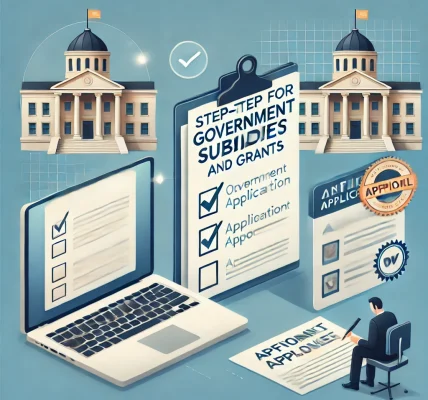Research and development (R&D) play a pivotal role in driving innovation, fostering economic growth, and addressing critical challenges across various industries. Whether you’re an entrepreneur, a startup, or an established research institution, accessing government grants for R&D can significantly enhance your ability to explore new ideas, develop new products, and push technological boundaries. In this article, we’ll delve into the available government grants for R&D, how to secure them, and tips to ensure you stand out during the application process.
Why R&D is Crucial for Innovation and Growth
R&D involves the systematic investigation and experimentation to create new knowledge, technologies, and solutions. For businesses and institutions, investing in R&D can lead to breakthroughs in product development, efficiency improvements, and competitive advantage. Government grants provide financial assistance to foster such innovation by reducing the financial burden on research teams and encouraging experimentation.
R&D is particularly important in areas such as:
- Technology & IT: To develop next-gen software, hardware, and artificial intelligence solutions.
- Healthcare: Creating novel medicines, vaccines, diagnostic tools, and treatment methods.
- Agriculture: Developing better farming practices, crop varieties, and pest control mechanisms.
- Clean Energy: Research into renewable energy technologies like solar, wind, and electric vehicles.
Governments recognize the value of R&D in advancing national priorities and are keen to fund projects that align with economic, social, and environmental goals.
Types of Government Grants for R&D
Governments across the globe offer a range of grants and funding opportunities to support R&D activities. These grants are typically designed to help businesses and research organizations access the necessary resources and expertise to develop innovative technologies or solutions.
Below are some of the most common types of government grants available for R&D:
- Basic Research Grants These grants typically fund exploratory research that aims to discover new concepts or theories in a particular scientific or technological field. Basic research is typically foundational, laying the groundwork for future applied innovations.
- Example: National Science Foundation (NSF) grants in the U.S. or Department of Science and Technology (DST) funding in India.
- Applied Research Grants These grants fund projects that aim to solve specific, practical problems by applying existing knowledge or technologies. Applied research is often industry-focused, with the goal of producing tangible products or processes.
- Example: Horizon 2020 funding for R&D in the European Union.
- Innovation & Commercialization Grants These grants help translate research findings into marketable products or technologies. They’re intended for businesses and institutions focused on taking innovations from the lab to the marketplace.
- Example: Small Business Innovation Research (SBIR) program in the U.S. or Innovation Fund in Canada.
- Tax Incentives for R&D Governments often provide tax incentives and rebates to companies involved in R&D, which can be an attractive option for smaller businesses and startups. These incentives aim to reduce the financial burden on R&D activities.
- Example: The R&D Tax Credit in the U.S. or the Research and Development Tax Relief scheme in the UK.
- Collaborative R&D Grants These grants are typically awarded to consortia of businesses, research organizations, and academic institutions working together on a specific research project.
- Example: Strategic Innovation Fund (SIF) in Canada.
- Sector-Specific Grants These grants target specific sectors where R&D is crucial, such as healthcare, energy, or agriculture. Governments tend to focus on areas of national importance, such as the development of new renewable energy sources or medical research into infectious diseases.
- Example: Renewable energy research grants from the Department of Energy (DOE) in the U.S.
How to Secure Government Grants for R&D
Securing government grants for R&D can be highly competitive. However, with the right approach and understanding of the process, you can increase your chances of successfully obtaining funding. Here are some essential steps to help you secure government grants for R&D:
1. Identify the Right Grant Program
The first step is identifying the government grant that best aligns with your research goals. Each grant program has specific eligibility criteria and funding priorities, so it’s crucial to choose one that matches your project’s focus. Take the time to thoroughly research available grant programs and ensure that your project aligns with the government’s objectives for innovation, economic development, or social benefit.
2. Understand the Application Process
Every government grant has its own application process, which may involve submitting a formal proposal, budget estimates, and detailed project plans. Before you apply, it’s essential to understand the documentation and compliance requirements. Failure to meet application requirements can result in disqualification. Government websites, grant portals, or consultants specializing in grant applications can provide you with specific guidance on submission formats, deadlines, and eligibility.
3. Develop a Strong Research Proposal
Your research proposal is the heart of the application process. A well-crafted proposal should clearly articulate:
- The problem you aim to solve and why it’s important.
- The innovative solution or approach you plan to develop.
- The methodologies and strategies you’ll use to carry out the research.
- Expected outcomes and impact, particularly how your research will benefit society or the economy.
Provide solid evidence supporting the feasibility and significance of your research. Be specific about the potential commercial applications of your work, and explain how it fits within the broader context of national or global priorities.
4. Provide a Detailed Budget and Timeline
A clear, detailed budget is essential when applying for government funding. Your budget should outline the total cost of your project, including personnel, materials, equipment, and any other expenses. Also, include a timeline with specific milestones, so the grant provider can track the progress of your research.
5. Collaborate with Research Partners
Many R&D grants require collaboration with universities, research institutions, or other businesses. Partnering with established research entities can strengthen your application and improve your credibility. It’s important to outline these partnerships in your proposal, highlighting how the combined expertise will enhance the success of your research.
6. Demonstrate Commercial Viability (If Applicable)
For innovation-focused grants, it’s important to demonstrate that your research has commercial potential. Outline how your innovation could be scaled or applied in the market. Potential investors or partners will want to see how your research can be monetized, and government grant providers may also consider this factor when deciding on funding.
7. Leverage Expert Advice and Support
Many governments offer advisory services or support to help applicants understand the requirements and improve their submissions. Take advantage of these resources to strengthen your application. Additionally, consider seeking the guidance of a professional grant writer or consultant, especially if you’re new to grant applications.
8. Follow Up on Your Application
After submission, stay in touch with the grant agency. Ensure that you meet any deadlines and respond to any additional requests for information. If your application is successful, be ready to provide progress updates or interim reports.
Common Mistakes to Avoid When Applying for R&D Grants
- Lack of Clarity: A vague or unclear proposal can lead to rejection. Ensure your objectives, methodologies, and expected outcomes are precisely defined.
- Ignoring Eligibility Criteria: Failing to meet the eligibility criteria is a common mistake. Read through the grant guidelines carefully to avoid disqualification.
- Overambitious Claims: Be realistic about what your research can achieve. Over-promising outcomes can lead to rejection.
- Incomplete Documentation: Missing or incomplete documents can result in delays or rejections. Ensure you submit all required information.
Conclusion
Securing government grants for R&D is an essential step for businesses and research institutions seeking to drive innovation and technological advancements. By understanding the available grants, following the right application process, and crafting a compelling research proposal, you can increase your chances of receiving funding. Government grants not only support the development of new technologies but also contribute to solving pressing societal and economic challenges. Stay focused, meet the criteria, and utilize available resources to unlock funding opportunities for your R&D projects.




